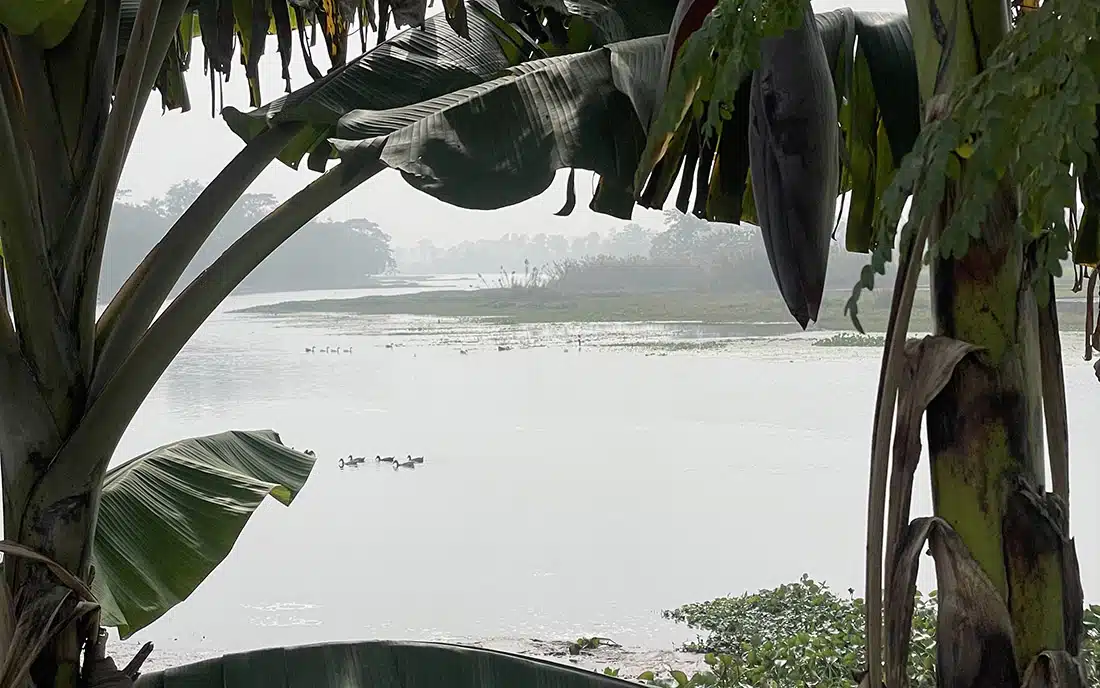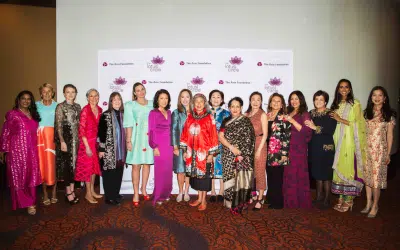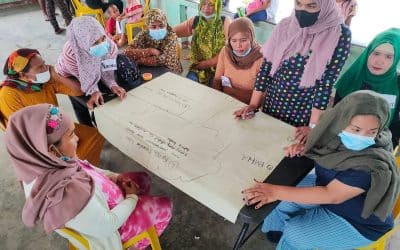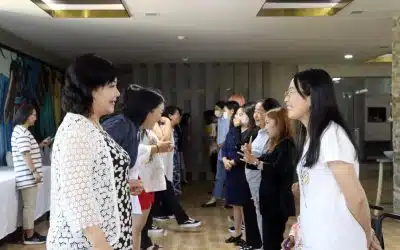InAsia
Insights and Analysis
Hearing Local Voices at the “Ground Zero” of Climate Change
March 20, 2024

The flood-prone island of Gabura is one of the most climate-vulnerable subdistricts in Bangladesh. The growing salinity of the water has reduced food security and damaged livelihoods in the area. (Photo: Tasnia Khandaker Prova)
Bangladesh is facing a climate emergency. Although it is one of the world’s least polluting nations, it is already experiencing some of the most severe effects of changing weather patterns. The country lies close to sea level, and much of the land is river delta that is prone to seasonal flooding, erosion, and salinity intrusion and faces the risk of devastating cyclones, all of which can be catastrophic for local communities and their livelihoods. Many families are unable to recover from such climate disasters and are forced to move to other parts of Bangladesh or across borders to rebuild their lives.
Unsurprisingly, Bangladesh has become a prominent voice in global conversations about climate change and the need for international responsibility-sharing. Developing nations generally shoulder an outsized share of the costs of climate change compared to wealthier nations, a fact recently recognized in global forums such as the United Nations Climate Change Conference, which convenes the annual Conference of Parties, or COP. In its 27th sitting, in 2022, the COP established a loss and damage fund for vulnerable countries, which was operationalized a year later at COP 28. While proponents celebrated this as a win, many practical challenges remain, including raising sufficient funds and figuring out how to measure losses and distribute resources equitably among nations.
The many intersecting consequences of environmental degradation require long-term solutions and a holistic approach. Mechanisms like the loss and damage fund will not increase climate resilience if social, political, and economic factors are not considered alongside the environmental ones. Migration and displacement of affected populations is one of the most significant consequences of climate change. Along with the downstream impacts on labor markets, social networks, and transnational relationships, these will need to be accounted for in national and international climate strategies and development policies.

The boats of fishers in the Sundarbans. Climate change has created new challenges for fishers in this transboundary mangrove forest, which is shared between Bangladesh and India. (Photo: Tasnia Khandaker Prova)
As “ground zero” for a shifting climate that is turning many environments inhospitable, Bangladesh offers a case study of these overlapping vulnerabilities. In parts of the borderlands with India, longstanding social and political fragilities lie beneath the new environmental stressors. The border itself has been an historical point of contention between the two countries, and security measures in the past have led to violence. The distance from central governance institutions in Dhaka can result in border regions being underrepresented in national climate strategies, including the distribution of resources, which can further marginalize ethnic and religious minorities within border communities. The risks from climate change in such areas of existing vulnerability cannot be overstated: economic instability, food insecurity, unreliable access to justice, and increased inequalities that can trigger communal violence.
Attempts to institutionalize sustainable solutions in climate-vulnerable areas must be rooted in a situated understanding of how communities experience and respond to environmental disruptions. Outsiders may struggle to grasp these nuances, which can lead to poor planning and interventions that cause further harm. In southwestern Bangladesh, for example, seasonal and informal migration to urban centers in India have become more and more of a survival mechanism for those who have lost their agricultural livelihoods. This can clash with policies that regulate cross-border movement, including the steady increase in border fencing. Researchers and practitioners working in affected areas can play an important role in collecting information and building evidence that speaks to local experiences, but this must be done with sensitivity and recognition of the power dynamics of classical research settings. Historically, the study of vulnerable populations in particular has been steeped in inequality and defined by an essentially extractive relationship between researchers and researched.

Along the river in this part of the project study area, an invisible, porous border divides India and Bangladesh. Community members couldn’t say whether the ducks swimming in the river were “Bangladeshi” or “Indian.” (Photo: Tasnia Khandaker Prova)
As the world mobilizes to support climate adaptation and resilience, decision-makers need analysis that reflects the needs and priorities of communities at the forefront of climate change. The Asia Foundation is working with the Centre for Peace & Justice (CPJ) of BRAC University in Bangladesh to develop a framework for assessing how existing drivers of fragility interact with the onset of climate change, in order to understand the risks for future climate resilience and development programming in the country. The Foundation’s partnership with CPJ originates in the UK-funded development research program XCEPT, Cross-Border Conflict: Evidence, Policy, and Trends, which works with local researchers to provide analysis of conflicts in border regions that is grounded in the affected communities.
With support from this program, CPJ has developed a new methodology for community-driven data collection, based on “participatory research,” that seeks to avoid the vertical power dynamics inherent in traditional research models. CPJ first employed this methodology among the Rohingya refugees seeking asylum in the Bangladeshi coastal town of Cox’s Bazar, on the border with Myanmar. A network of researchers drawn from within the refugee community itself enabled the affected population to become coproducers of knowledge and solutions, building trust between aid providers and recipients and strengthening the credibility of the research findings. The insights this yielded have helped foreign donors and humanitarian agencies operating in the world’s biggest refugee camp to work more effectively. This approach is a major contribution to localizing aid, as it shifts power over information towards the affected populations.

How researchers reached the Gabura study site. (Photo: Tasnia Khandaker Prova)
This year, CPJ is piloting the same research approach in southwestern Bangladesh, applying it to the question of how climate adaptation strategies reflect and respond to broader social and political fragilities in the local context. A scoping study first undertaken by the team in 2022 determined that this question is a major factor in the long-term success of such strategies. Subsequently, a research project was designed replicating the approach used in Cox’s Bazar, starting with the recruitment and training of young people to work as “community researchers.”
The team faced some initial challenges: refugee camps are an entirely different operational context than areas of the general population, because of the institutional control within the camps and the relative immobility of the camp population. Furthermore, the severity of the refugee crisis in Cox’s Bazar was a powerful motivator for camp residents to participate. In southwestern Bangladesh, on the other hand, researchers wondered how to build interest among local youth in participating in the data collection and how to encourage respondents to open up about their experiences and aspirations. Researchers have also reflected that the obstacles facing Rohingya refugees in their fenced camps are immediate and tangible, while slow-onset climate factors that distress and uproot communities in climate-affected border towns are less immediately apparent.

Project researchers walk to a household at one of the study sites in the Bangladesh-India borderlands. (Photo: Era Robbani)
To apply a proven methodology in a completely new context, both major and seemingly minor aspects of the research study may need to be revised. CPJ’s community-based research approach acknowledges the complexity and unique social order of the borderlands, allowing for a more comprehensive understanding of the study sites. Climate realities around the world are not equal. These locally grounded methods of exploration avoid the mistakes of knowledge systems that force top-down assumptions on local communities, and instead empower them to be the voices of their own experience.
The initial phase of this new project is nearing completion, and community researchers are receiving training for the first round of data collection. From where we stand now, there is much to discover, to learn, and to unlearn, and we hope to do it together.
Tabea Campbell Pauli is a senior program officer with The Asia Foundation’s XCEPT program, and Tasnia Khandaker Prova is a research associate with the Centre for Peace and Justice of BRAC University. They can be reached at [email protected] and [email protected], respectively. The views and opinions expressed here are those of the authors, not those of The Asia Foundation.
About our blog, InAsia
InAsia is posted and distributed every other Wednesday evening, Pacific Time. If you have any questions, please send an email to [email protected].
Contact
For questions about InAsia, or for our cross-post and re-use policy, please send an email to [email protected].The Asia Foundation
465 California St., 9th Floor
San Francisco, CA 94104
The Latest Across Asia
News
April 25, 2024
Program Snapshot
April 18, 2024
News
April 17, 2024

2024 Lotus Leadership Awards
The Lotus Leadership Awards recognize contributions towards gender equality in Asia and the Pacific







0 Comments